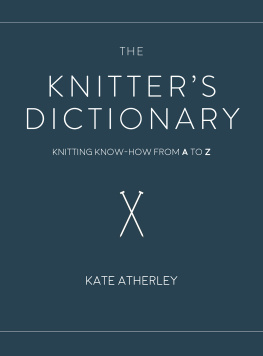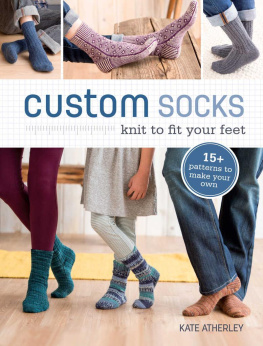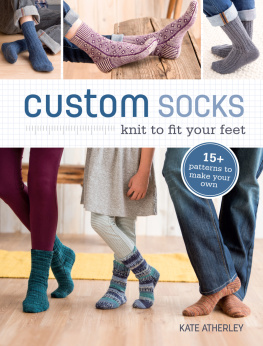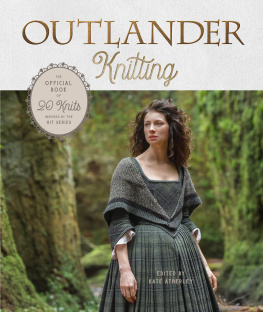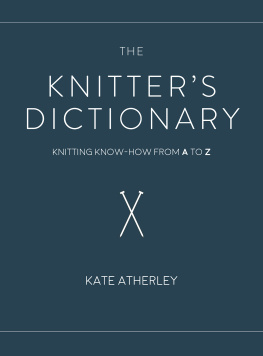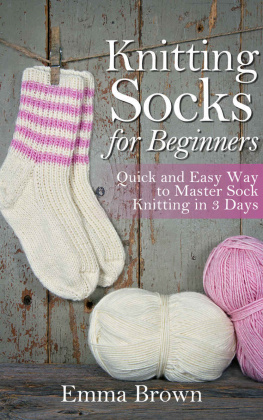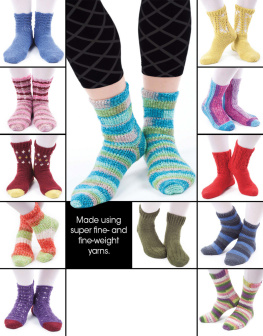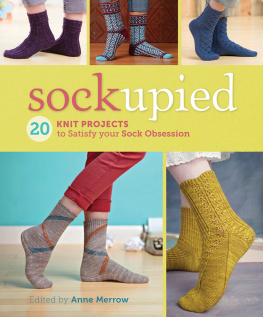Contents
Guide
THE
KNITTERS
DICTIONARY
KNITTING KNOW-HOW FROM A TO Z


CONTENTS
DEDICATION
For my parents, who never refused me a book.
INTRODUCTION
I first learned to knit when I was a young girl, at my grandmother Hildas knee. I was a very confident maker of doll blankets and scarves at an early age. Spurred on by her clear instruction, my ability to form perfect stitches and manage yarn and needles was firmly formed.
When I picked up the needles again, as a teenager, I had moved far away from her. So I found myself a pattern for something that looked easy to knit, chose a ridiculous brightly colored yarn, and sat down, keen to start working.
But I was utterly lost. I was fine with the needles and yarn, but I couldnt make any sense of the instructions. Handling the needles and yarn was an entirely different skill than reading the patterns. Although my grandmother had made sure I was a master at the first, we had never gotten around to the second topic in our lessons: the language, rules, and codes embedded in knitting patterns.
There are many books, magazines, online tutorials, and store classes that show you the mechanics of knitting, but very few that address how to read the instructions. Thats what this book is all about.
Knitting has its own language: technical terms, funny abbreviations, and familiar words used in very particular waysrepeat, even, right side, etc. Knitting patterns are like little computer programs, with their own rules and notations.
This book is a guide to help you understand that language and patterns. If youre able to read the instructions, youll be able to successfully knit them.
Weve organized items alphabetically, and its squarely between a dictionary and an encyclopedia. As youre working through a project, youve got a quick way to look up a term youre not familiar with. Some sections are larger, providing not only guidance on the individual words, but on the larger context to expand your knitting knowledge.
Wonder why designers are always going on about gauge? Want to know more about the differences between a raglan and a set-in sleeve sweater, and why it matters when youre choosing a pattern? And what is heavy worsted, exactly? This book aims to answer all those questions and more, to help you break the code, and be a more powerful and successful knitter. Its one I think youll want to keep in your knitting bag, always.
GETTING STARTED WITH PATTERNS
Before you pick up your needles and start knitting, its a good idea to take a moment to familiarize yourself with your pattern and gather all the tools and materials you need.
SET-UP FOR SUCCESS
Before you start working on a pattern, make sure you have the most recent version. If you downloaded it from a website, check for updates. If youre working from a book or magazine pattern, do a quick web search to see if the publisher has posted any corrections (; see p. 41).
If youre working from a digital pattern, make a backup copy; if youre working from a paper pattern or book, print or photocopy the pattern (when permitted under the publishers copyright statement) and store the original somewhere safe. Put your working copy in a plastic sheet protector to protect it from coffee spills.
If working from paper, keep some scrap and a pencil handy for taking notes and tuck the notes inside the sheet protector. If you are working from a digital pattern, make sure you keep your notes as a separate file or as annotations to the pattern file.
If its a multisize pattern, go through and highlight the numbers for the size youre working throughout the instructions. At the same time, scan the pattern for things you might want to know before you begin. In particular, look for the phrases (see p. 90), as these need some advance planning.
Many patterns offer explanations of terms, abbreviations, and special techniques. Its important to familiarize yourself with those. Keep your Knitters Dictionary handy for anything that might not be explained.
TOOLS
Review the materials, needles, and notions list for the project: put them all in one place so theyre ready when you need them. Make sure to include stitch markers, a tape measure, scissors, and a yarn needle (see ; p. 81); these sometimes arent included on the list, but youll probably need them.
I also like to make sure that I have some safety pins, a crochet hook for picking up dropped stitches, stitch holders and/or scrap yarn I can use as a stitch holder, a ruler, and a needle gauge on hand as well.
Keep the extra skeins of yarn youre not actively using in a plastic ziplock-style bag, away from moths, dust, and inquisitive pets and children. Keep the receipt, and if youre working from skeins that need to be wound before use, dont wind all of them. If you dont use them all, you may well be able to return or exchange. To that end, its good to know what your store return policies are when buying yarn. And if they wont take back the leftover skein or two, you can always use them for something else... hats and mittens dont require much yarn!
SIZE AND FINISHED MEASUREMENTS
Many knitted items have multiple sizessocks, mittens, hats, garments. For these, youll need to decide which size you want to make.
Not all knitting patterns present sizing information in the same way. However, you should be able to find some semblance of the following in any pattern: indicator of sizes, finished measurements, and a schematic. The most helpful patterns will also provide some kind of fit or sizing recommendation. See (p. 39) for more information on how to choose what size to make.
size
A pattern may or may not list a size. This is sometimes labelled as to fit. Its essentially what youd see written on the label inside commercially made clothes: simply a rough indicator of the relative bigness or smallness of the piece. It provides a guide to who the pattern is for, but it should be very much a secondary consideration when deciding which size to make. For more information on how to choose a size, see (p. 98).
finished measurements
Names vary, but this section tells you the dimensions of the actual pieces as knitted (once blocked). These are what youd get if you put the knitted item on a flat surface and took a tape measure to it. See (p. 47) for more information.
GAUGE
A pattern should list a gauge, which is a measurement of how many stitches and rows you should achieve over a certain distance (usually per inch [2.5 cm]). This information does two things: it helps you choose yarn and helps you identify which size needles to use. Ultimately, the purpose of gauge is to help you make sure that the piece you knit comes out to be the correct size! See (p. 51) for more information.
YARN
All patterns should recommend a yarn and tell you the yarn used in the sample shown. See (p. 45) for more information on the properties of commonly recommended yarns.
yarn substitution
You might want to work the project with the yarn specified in the pattern, but you dont have to. After all, it might not be available in your area, or it could well have been discontinued.
If you choose not to use the yarn specifically listed in the pattern, find something as close to it as you can in fiber mix, coloring, and texture. Doing so will help you achieve results similar to what you see in the pictures. In general, a project with lots of texture looks better knit with a smooth yarn in solid or nearly solid colors; plainer patterns suit busier colors and more textured yarns. For more information, see (p. 119).

